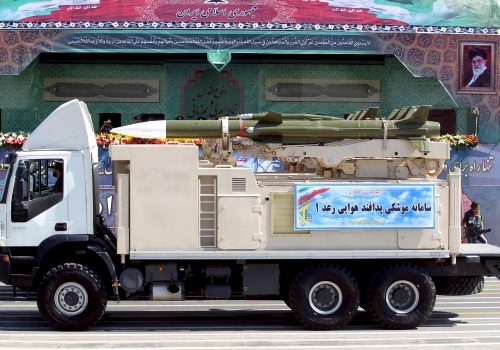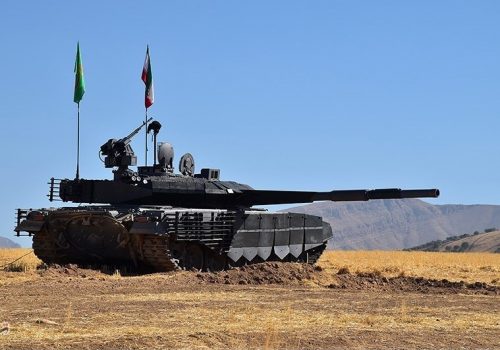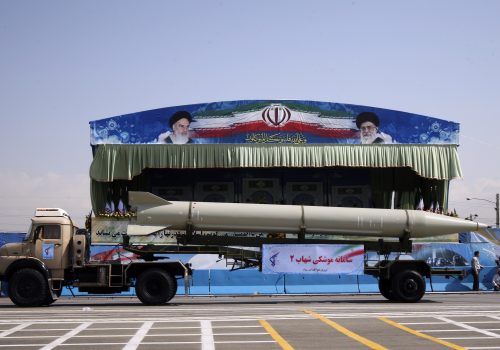November 10, 2021
Is Iran going on an arms shopping spree in Moscow?
During a recent visit to Moscow in mid-October, Iran’s armed forces Chief of Staff General Mohammad Bagheri met with Russian Defense Minister Sergey Shoigu and confirmed that Tehran might be interested in buying some new Russian weaponry.
Iran has frequently turned to Russia for arms it could not produce at home, including a much-delayed procurement of the S-300 long-range surface-to-air missile system. In addition, Iran has purchased Kilo-class (Type 877EKM) submarines, T-72 tanks, BMP-2 infantry armored vehicles, Mi-17 helicopters, and various anti-tank systems (such as the 9K115-2 Metis-M guided missiles). Even the late Shah Mohammad Reza Pahlavi made some orders in Moscow—for BTR-50 and BTR-60 armored vehicles and ZSU-23-4 anti-aircraft guns, for example—despite his much heavier reliance on US arms. The Islamic Republic’s largest Russian deliveries were in the 1990s, when Iran was rebuilding its armed forces after the 1980-88 war with Iraq, while a cash-strapped Russia desperately sought export opportunities.
There are several reasons why Russia is a convenient supplier of military hardware to Iran now. Russia has no sanctions on Iran for human rights abuses or terrorism, which bar most Western countries from selling weapons to Tehran. The Kremlin exports arms to several states with poor human rights records and that are under Western sanctions, including Myanmar, Syria, Algeria, and Venezuela.
Another significant advantage for Iran is the relatively lower procurement and maintenance cost of Russian equipment. For instance, a single German-made Leopard 2A7+ tank—recently procured by Qatar and Hungary—costs roughly $10 million, while the unit price of the Russian T-14 Armata is about $4 million. Currently, Russia has been equipping its armored forces with the T-72B (B3 and B3M/B4) variants, costing $2 million per tank. For Iran, which has been using older variants of the T-72, this would be a logical upgrade, since both crews and ground personnel would need less time to learn how to use them.
A third important advantage for Iran is that Russian law doesn’t oblige companies to report on arms exports and, in fact, encourages secrecy. This is in line with Iran’s preference when it comes to security and defense.
What kind of equipment would be on Iran’s shopping list? The US Defense Intelligence Agency believes Iran would like to buy Su-30 fighters, Yak-130 trainers, T-90 tanks, S-400 surface-to-air missile defense systems, and K-300P Bastion mobile coastal defense missile systems. During his recent trip to Moscow, General Bagheri suggested that Tehran was interested in “fighter jets, training jets, and combat helicopters from Russia.”
A focus on aerial systems is understandable. Although Iran has been developing ballistic missiles and various Unmanned Aerial Vehicles, a conventional fleet is still instrumental in modern warfare. New multirole fighters and enhanced air defense would be crucial during Iran’s most plausible war scenario: countering an Israeli air strike on its nuclear facilities. A major land invasion is highly unlikely and Iranian ground forces currently have sufficient capability to conduct operations in Iraq, Afghanistan, or Iranian Kurdistan.
Iran, which has an extremely outdated conventional aircraft fleet, is most likely interested in the Sukhoi Su-30, a twin-engine, two-seat fighter. For Tehran, the best solution would be to order the SM2 configuration, which is the most advanced variant. It is now being introduced into the Russian air force. Compared to the SM, the SM2 has more powerful AL-41F1S engines and improved radar (known as N035 Irbis—also used by Su-35S multirole fighter aircraft). The Su-30SM/SM2 is intended to replace the Su-24M and Su-27 jets (the former is still operational in Iran). Unfortunately for Tehran, the SM and particularly the SM2 might be beyond Iran’s financial capacity. Therefore, Tehran might have to choose the Su-30SME, a cheaper and downgraded variant. The unit price is not public, but it was speculated that Belarus paid roughly $50 million for each Su-30SM.
The Su-30 would be a good asset if Iran could also get the Su-35, a twin-engine single-seat fighter jet, also developed from the Su-27. While both types are able to attack ground and surface targets, the Su-35, which debuted internationally in 2013 during the Le Bourget airshow in France, is better designed for so-called air dominance duties (i.e. for air-to-air operations). Due to its targeting systems and armaments, the Su-35 is now the most advanced aircraft in the Russian Air Force. Thanks to its Irbis radar, every Iranian Su-35 can track up to thirty aerial targets and engage targets from a long distance. However, cost would once again be a major obstacle.
Nevertheless, Iran might be tempted to look for a more economical option and procure the MiG-29 fighters designed during the Soviet era. Although Iran has two squadrons of very basic and outdated A/UB variants, they are still the backbone of Tehran’s air fleet. Russian company Mikoyan has been mostly promoting the MiG-35 air superiority jet, which is a development of the MiG-29M/M2/K/KUB, but it could also undoubtedly deliver older variants. Both MiG-29 and MiG-35s are offered for export.
The other option is the Yak-130: a subsonic, twin-engine training aircraft, which can also be used as a light fighter or close support aircraft. It is offered by Russia but was co-designed in cooperation with Italy. This plane would give the Iranian Air Force a much-needed technological and industrial boost. While the Yak-130 cannot compete with modern multirole aircraft, apart from training Iranian pilots, the plane could be used to monitor national airspace and support ground forces. Currently, these tasks are carried out by aircraft procured under the Shah—the F-5 and F-4 Phantom II—which need urgent replacement. Moreover, the Yak-130 is relatively easy to maintain even for less developed countries and has been purchased by Belarus, Algeria, Bangladesh, Laos, Syria, and Myanmar.
Regarding combat helicopters, Iran still possesses the US Bell AH-1 SuperCobra. Some were locally modernized, but all should be replaced soon due to fatigue, outdated capabilities, and lack of spare parts. Russia could potentially offer an upgraded export variant of the Mi-24. The Mi-35 is used not only by Russia, but also Afghanistan (at least until recently), Mali, Venezuela, Brazil, Azerbaijan, and Cyprus. This is a highly capable workhorse in modern warfare: Mi-24/35 helicopters are heavily armored and armed and can efficiently support troops. Another advantage is that they can transport troops to remote areas, which exist abundantly in parts of Iran. Russia’s export portfolio also includes Mi-28NE assault helicopters, which Iranian experts most likely had a chance to see in Iraq, where they still serve in Iraqi Army Aviation.
Still, even officially-confirmed interest does not mean that orders for Russian military equipment are certain. Media reports on planned procurements worth $10 billion in 2016 never panned out. Political considerations—such as Iran’s failure to return to compliance with the 2015 nuclear deal, which Moscow is a signatory to—might also be a factor. Russia stalled on supplying Iran with the S-400 air defense system and has reportedly declined Iran’s request for offensive weapons in the past. Moscow doesn’t want to destabilize the regional balance of power and undermine its good ties with Iran’s rivals, Saudi Arabia and Israel. Ultimately, the biggest obstacle might be Iran’s deep and continuing financial problems. With the Islamic Republic in serious economic crisis, the government might have more urgent priorities than Russian military equipment.
Robert Czulda is an assistant professor at the University of Lodz, Poland and a former visiting professor at Islamic Azad University in Iran, the University of Maryland and National Cheng-chi University in Taiwan. He is the author of Iran 1925 – 2014: From Reza Shah to Rouhani. Follow him on Twitter: @RobertCzulda.
Further reading
Wed, Jul 29, 2020
Iran’s air attack tools have limited utility against adversaries
IranSource By
From Tehran’s point of view, a strong emphasis on air attack tools is understandable and reasonable. However, it is important not to overestimate the impact these means can deliver.
Tue, Jun 9, 2020
Lack of modern technologies hampers Iran’s defense industry
IranSource By
While, in many countries, defense companies are private, they are state-owned in Iran. Because of the Islamic Republic’s long pariah status, interaction with the outside world has been limited.
Tue, Jun 9, 2020
Post-embargo, Iran arms purchases would be limited and selective
IranSource By Barbara Slavin
Iran's purchases will likely be limited, by both economic and geopolitical constraints, including the impact of US sanctions and the coronavirus pandemic and caution on the part of potential suppliers.
Image: Vehicles carry tanks during an Iranian Army exercise dubbed "Fatehan of Kheibar", in the northwestern parts of Iran, in this picture obtained on October 1, 2021. Iranian Army/WANA (West Asia News Agency)/Handout via REUTERS


